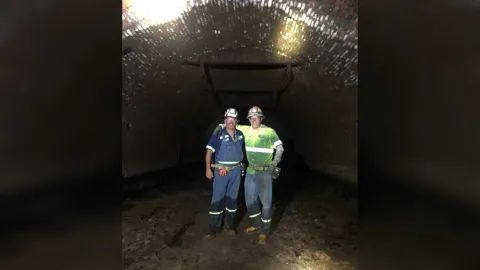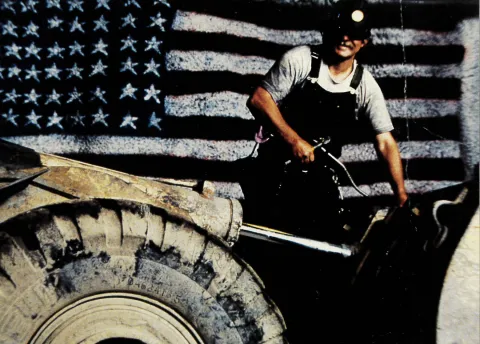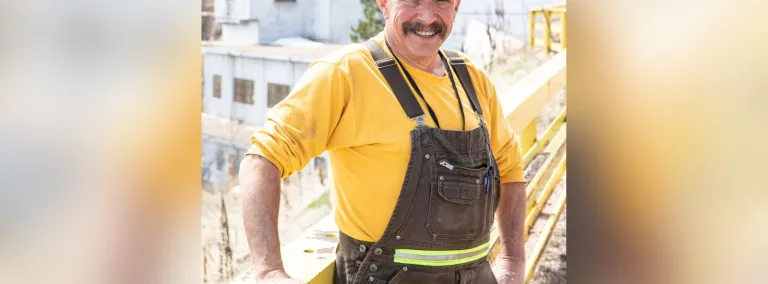After 10 years, Hover retires from SURF Emergency Response Team
Paul “Woody” Hover built SURF’s dedicated emergency response team, leveraging safety expertise and familiarity with facility
There are more than 370 miles of tunnels, drifts, and shafts beneath the City of Lead, South Dakota. After three decades at the underground facility—two with the Homestake Gold Mine (Homestake) and one with the Sanford Underground Research Facility (SURF)—Paul “Woody” Hover knows them well.
With just a few weeks before he retires from his role as SURF’s Emergency Response Team (ERT) supervisor, Hover is revisiting some of the more memorable underground spaces. “I’m revisiting some of these places, knowing it will be the last time I get the chance,” Hover said.
Last week, Hover completed a safety walkthrough of the 1100 Level, home to an expansive cavern known as the “blacksmith shop.” Unique for being one of the only underground spaces with walls and an arched ceiling made of brick, the workshop dates to the early 1900s and was used to repair mining equipment without bringing it to the surface. On his last visit to the blacksmith shop, Hover was joined by his son, William Hover, an infrastructure technician in the Yates Shaft.

At nineteen, Hover moved from the New York City metropolitan area to the small mining town of Lead. He worked as a miner, motorman, maintenance staff, and mobile equipment operator underground at Homestake for nearly 20 years. “I headed West seeking fame and fortune,” Hover said. “I haven’t found either, but by God, I’ve found a place I like.”
Most of his time at Homestake was spent in the “deep country,” more than a mile underground. There, he developed the reputation of resident artist.
“I painted pretty much everywhere I went,” Hover said. “It was all rattle-can style, just to add some color to the place. I wasn’t the only one doing it; I just maybe did more than anyone else. I did a mountain landscape on the loader barn air doors and some Harley Davidson wings at the 15 Ledge shop.”
One painting on the 7400 Level depicted a large American flag. The uneven rock surface made the flag appear to be waving in the wind. Though the 7400 Level has remained underwater since the mine shut down the water pumps in 2003, Hover’s painting lives on, featured on a popular postcard at the Sanford Lab Homestake Visitor Center.

Hover was invited to join Homestake’s Mine Rescue Team in 1995. “After joining, I discovered how much I enjoyed emergency services work,” Hover said. “I’ve been involved in safety at various facilities ever since; it was like a second career for me.”
In 1998, a sustained decrease in the price of gold caused Homestake to lay off hundreds of employees, including Hover. For the next decade, he worked across the western United States in several mining and safety roles.
Following Homestake’s closure, a campaign began to transform the underground facility into a dedicated science facility and, in 2007, SURF was born. Hover returned to the facility as a safety specialist from 2010 to 2015.
As SURF grew, the need for an around-the-clock, full-time personnel dedicated to rescue and safety maintenance became evident. In 2018, Hover returned once more, bringing an expertise in safety and an extensive familiarity with the facility’s underground workings to the role of Emergency Response Team supervisor.
Hover began recruiting a skilled team with backgrounds in firefighting, emergency medical services, and search and rescue. He developed a robust training program to familiarize the team with the hazards of working underground, including rope and confined space rescue, as well as research-related hazards like cryogens, oxygen-deficient atmospheres, and chemical and acid handling. Today, SURF’s ERT includes 11 full-time team members and 23 part-time (or volunteer) members.
“Woody has built an amazing crew,” said Julie Ewing, director of Environment, Safety, and Health at SURF. “His legacy is a highly skilled, knowledgeable team that we can trust in times of emergency.”
The team isn’t just for SURF; they are ready to respond to any emergencies that may arise in the local community. Hover has coordinated cross-agency training exercises with local fire departments and Search and Rescue teams; National Guard Civil Support Teams in South Dakota, Wyoming and Montana; and the Department of Homeland Security.
“Woody built up this team from scratch,” said Barry VanSickle, who joined SURF’s ERT team in 2019 and will serve as the new ERT supervisor. “He recruited us and developed the roadmap of our training and duties across the facility. Woody treated his team really well, and he will be missed.”
In his career at SURF, Hover has had several unique experiences — from seeing a Black Hawk helicopter land onsite to being an extra on “Jeopardy!” — but what he’ll miss the most are the monthly training exercises with his team.
“The camaraderie of running through the training scenarios as a team, of working together to develop the skill sets that bring a positive outcome to a potentially bad situation—that’s what I’ll miss,” Hover said.
